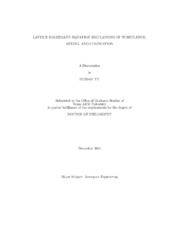| dc.contributor.advisor | Girimaji, Sharath S | |
| dc.creator | Yu, Huidan | |
| dc.date.accessioned | 2006-04-12T16:02:07Z | |
| dc.date.available | 2006-04-12T16:02:07Z | |
| dc.date.created | 2004-12 | |
| dc.date.issued | 2006-04-12 | |
| dc.identifier.uri | https://hdl.handle.net/1969.1/3081 | |
| dc.description.abstract | We explore the capability of lattice Boltzmann equation (LBE) method for complex
fluid flows involving turbulence, mixing, and reaction.
In the first study, LBE schemes for binary scalar mixing and multi-component
reacting flow with reactions are developed. Simulations of initially non-premixed
mixtures yield scalar probability distribution functions that are in good agreement
with numerical data obtained from Navier-Stokes (NS) equation based computation.
One-dimensional chemically-reacting flow simulation of a premixed mixture yields a
flame speed that is consistent with experimentally determined value.
The second study involves direct numerical simulation (DNS) and large-eddy
simulation (LES) of decaying homogenous isotropic turbulence (HIT) with and without
frame rotation. Three categories of simulations are performed: (i) LBE-DNS in
both inertial and rotating frames; (ii) LBE-LES in inertial frame; (iii) Comparison
of the LBE-LES vs. NS-LES. The LBE-DNS results of the decay exponents for kinetic
energy k and dissipation rate ε, and the low wave-number scaling of the energy
spectrum agree well with established classical results. The LBE-DNS also captures
rotating turbulence physics. The LBE-LES accurately captures low-wave number
scaling, energy decay and large scale structures. The comparisons indicate that the
LBE-LES simulations preserve flow structures somewhat more accurately than the
NS-LES counterpart.
In the third study, we numerically investigate the near-field mixing features in low
aspect-ratio (AR) rectangular turbulent jets (RTJ) using the LBE method. We use
D3Q19 multiple-relaxation-time (MRT) LBE incorporating a subgrid Smagorinsky
model for LES. Simulations of four jets which characterized by AR, exit velocity,
and Reynolds number are performed. The investigated near-field behaviors include:
(1) Decay of mean streamwise velocity (MSV) and inverse MSV; (2) Spanwise and
lateral profiles of MSV; (3) Half-velocity width development and MSV contours; and
(4) Streamwise turbulence intensity distribution and spanwise profiles of streamwise
turbulence intensity. The computations are compared against experimental data and
the agreement is good. We capture both unique features of RTJ: the saddle-back
spanwise profile of MSV and axis-switching of long axis from spanwise to lateral
direction.
Overall, this work serves to establish the feasibility of the LBE method as a
viable tool for computing mixing, combustion, and turbulence. | en |
| dc.format.extent | 2411706 bytes | en |
| dc.format.medium | electronic | en |
| dc.format.mimetype | application/pdf | |
| dc.language.iso | en_US | |
| dc.publisher | Texas A&M University | |
| dc.subject | lattice Boltzmann equation | en |
| dc.subject | scalar mixing | en |
| dc.subject | premixed reacting | en |
| dc.subject | DNS | en |
| dc.subject | LES | en |
| dc.subject | decaying isotropic turbulence | en |
| dc.subject | rectangualr turbulent jet. | en |
| dc.title | Lattice Boltzmann equation simulations of turbulence, mixing, and combustion | en |
| dc.type | Book | en |
| dc.type | Thesis | en |
| thesis.degree.department | Aerospace Engineering | en |
| thesis.degree.discipline | Aerospace Engineering | en |
| thesis.degree.grantor | Texas A&M University | en |
| thesis.degree.name | Doctor of Philosophy | en |
| thesis.degree.level | Doctoral | en |
| dc.contributor.committeeMember | Hurtado, Johnny | |
| dc.contributor.committeeMember | Annamalai, Kalyan | |
| dc.contributor.committeeMember | Cizmas, Paul | |
| dc.type.genre | Electronic Dissertation | en |
| dc.type.material | text | en |
| dc.format.digitalOrigin | born digital | en |


